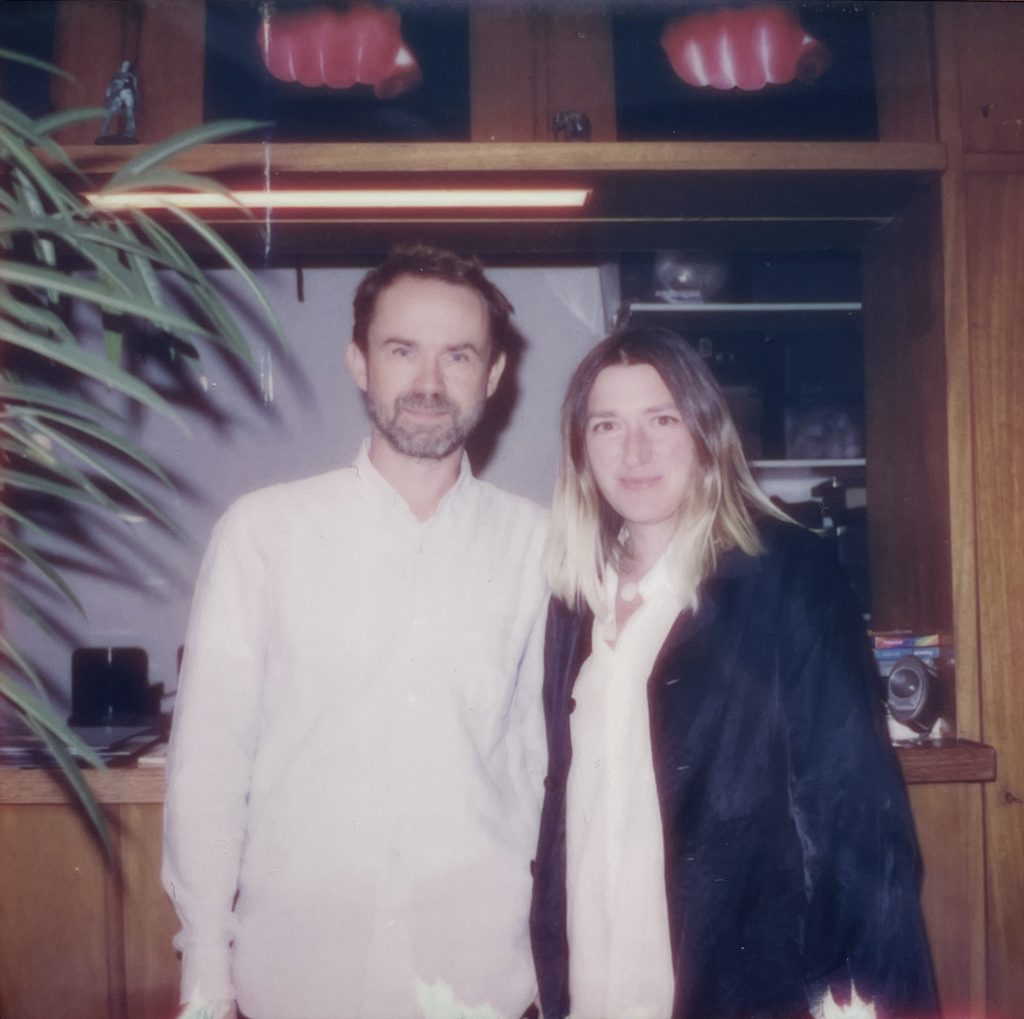The Back Room
The Back Room: From Publisher to Market Player
This week: Loyal gallery’s unusual path to longevity, Patrick Drahi’s unsentimental approach to art financing, Edgar Plans’s market moment, and much more.

This week: Loyal gallery’s unusual path to longevity, Patrick Drahi’s unsentimental approach to art financing, Edgar Plans’s market moment, and much more.

Artnet News

Every Friday, Artnet News Pro members get exclusive access to the Back Room, our lively recap funneling only the week’s must-know intel into a nimble read you’ll actually enjoy.
This week in the Back Room: Loyal gallery’s unusual path to longevity, Patrick Drahi’s unsentimental approach to art financing, Edgar Plans’s market moment, and much more—all in a 7-minute read (2,022 words).
__________________________________________________________________________

Martin Lilja and Amy Giunta of Loyal Gallery. Photo: Jean-Baptiste Béranger, courtesy of Loyal.
Tim here. With much of the gallery sector often seeming as if it’s been built off the same standard blueprints, I think it’s worth a deeper look whenever a dealer manages to blaze an unorthodox trail to long-term success. That’s why I profiled the Stockholm gallery Loyal in this week’s Gray Market.
What sets Loyal apart isn’t just that the gallery began as, of all things, an upstart art magazine. It’s also that Loyal’s prescient eye for talent and deft touch in relationship building has led to real longevity in a market more and more hostile to its middle tier every year.
Since 2005, Loyal has organized early solo shows with an eye-popping array of international artists, from Katherine Bernhardt and Eddie Martinez in the mid-aughts, to now-rising stars Mario Ayala and Lauren Quin.
More impressively, the gallery has maintained many of its oldest (and now richest) professional connections without embarking on a typical multi-city expansion campaign.
So, how exactly did this happen? And what can we learn from it?
In 1995, a Swedish math student named Martin Lilja and his then-girlfriend, Marilyn Petridean, moved to London, where they eventually met a Swedish photographer named Kristian Bengtsson. After forming a fast friendship over their shared creative interests, the trio returned to Sweden and launched an independent art and culture magazine called Loyal in 2000.
Over the next five years, Loyal was released twice annually. Yet both the end product and the editorial personnel were in near-constant flux over its 10 issues. Most crucially, Petridean moved on from Loyal after issue two, and in 2001, Lilja met Amy Giunta, a native New Yorker who quickly became a key member of Loyal’s brain trust forevermore. (She and Lilja married in 2004.)
Notable contributors spanned a slew of artists and members of the independent music and literary scenes: David Shrigley, Graham Coxon (of Brit-pop legends Blur), Daniel Johnston, Rita Ackermann, and even the now-infamous JT LeRoy showed up in some form on Loyal’s pages.
The magazine also became “more and more ‘art’ over time,” in Lilja’s words. This was largely because of the way its network expanded amid a group of young artists with talent and ambitions but few pre-existing footholds in the art establishment.
Eddie Martinez was a prime example. Lilja recalls meeting him at a pop-up exhibition in New York circa 2003–04, when Martinez would have been no older than 27. Although he had not yet been given his first solo gallery show, Lilja and company immediately sparked to Martinez’s riotous, vocabulary-stretching imagery.
The artist soon began contributing artworks to Loyal. More importantly, the collaboration reinforced a way of working with artists that would help launch the business into its next phase as a gallery.
(For clarity, what follows is my own sense of what Loyal has done so well, not an actual program devised by Lilja and Giunta, who took full control of Loyal after Bengtsson moved on in 2009.)
Although the transition from specialty publisher to talent-spotting emerging gallery came with its fair share of anxiety, it was also more natural than it might have appeared from afar.
Every issue of Loyal was essentially a curated show in print. A tight budget and the rudimentary state of digital communication in the early 2000s meant that contributing artists were generally shipping physical works to Lilja and Giunta to scan and ship back. The same work of relationship building and relationship maintenance went into both enterprises.
No wonder Loyal is not the only gallery to grow out of printed matter. Brendan Dugan launched Karma in 2011 as a combination publishing house and exhibition space; Harper Levine began as a rare books dealer before the fateful acquisition of a first-rate library of photography books circa 2005 broadened his clientele to include art and photography collectors.
Today, Karma and Levine’s namesake business Harper’s count at least four permanent exhibition spaces in New York and L.A. each, as well as a dedicated bookstore apiece. Loyal didn’t just pre-date these other dealers; it also stands alone in opting out of the real-estate acquisition game.
Yet that choice has done little, if anything, to sever its ties to artists who have become market forces.
_______________________________________________________________________________
While permanent expansion is still off the agenda, Lilja and Giunta aren’t standing still. During Frieze L.A. 2023, they staged their first U.S. gallery show: a pop-up in the historic El Royale Apartments blending early discoveries (such as Michelle Blade, Heidkamp, and Martinez) with ascendant recent collaborators (such as Ross Caliendo, Emmanuel Louisnord Desir, and Hiejin Yoo).
Lilja said that he and Giunta hope to program one or two shows a year in L.A. going forward to complement their six annual shows in Sweden. Temporary exhibitions elsewhere in Europe are also a possibility.
But the only sure thing is that the magazine-turned-gallery isn’t inclined to follow expectations for what a dealer with nearly 20 years of experience should do next—and that may be the best advice of all.
_______________________________________________________________________________
The latest Wet Paint looks at Tribeca gallery LOMEX’s latest roster addition: Japanese artist Yoshitako Amano, best known as the designer behind the anime adaptation of Speed Racer and the ultra-popular video game franchise Final Fantasy.
Plus, buckle up for a raft of revelations about the high-profile art-world divorce between painters Ann Craven and Peter Halley.
Here’s what else made a mark around the industry since last Friday morning…
Art Fairs
Auction Houses
Galleries
Institutions
Legal News and Obituaries
_______________________________________________________________________________
“A Sotheby’s relationship manager will naturally be inclined to err on the side of grace when it comes to late payments from a borrower… The buyer of a securitized loan, however, has no interest in the value of the relationship and will insist that Sotheby’s treat the loan in a dispassionate and narrowly profit-maximizing manner. That’s exactly the unsentimental signal [Patrick] Drahi wants to send—not only to potential borrowers but even to Sotheby’s own staff.”
—Finance journalist Felix Salmon, unpacking the paradigm shift in auction-house priorities implied by reports that Sotheby’s is looking to securitize the loans made by its financial services division. (Axios)

Edgar Plans, Colors (2020). Image courtesy Christie’s Images Ltd. 2023
_______________________________________________________________________________
Date: 2020
_______________________________________________________________________________
Estimate: $73,000 to $116,000 (CNY500,000 to CNY800,000)
_______________________________________________________________________________
Sold for: $698,569 (CNY4.4 million)
_______________________________________________________________________________
Sold at: Christie’s Shanghai
_______________________________________________________________________________
Sold on: March 1, 20222
_______________________________________________________________________________
This week, we put the spotlight on Edgar Plans, a 45-year old Spanish artist who has become a market sensation thanks to the craze in Asia for kawaii art, a reference to the culture of cuteness in Japan.
Though the artist himself rejects the kawaii label, auction house executives have attributed the success to Asian collectors looking for a replacement after being priced out of the market for works by artists such as Yoshitomo Nara, and his knack for world building around his charming mouse-eared characters.
Plans’s work has appeared at auction nearly 300 times since it first crossed the auction block in 2020. In 2022, his work pulled in an eye-popping $12 million in auction sales, with works selling on average for $84,784. The record for a work to date is $698,569 paid for Colors (2020) at an evening auction at Christie’s Shanghai last March.
The froth appears to be cooling a little in 2023. Some 31 lots have been offered so far this year, with a slightly more adorable average sale price of $29,254. The most significant work to be offered this year, a group scene estimated to bring in $154,205 and $269,858 at Seoul Auction on Tuesday, failed to find a buyer. Still, while nothing offered so far has approached his record, there is clearly continued appetite for his work, with 13 lots surpassing their high estimates, and the priciest netting $213,266 at Phillips day sale in London earlier this month.
—Eileen Kinsella
_______________________________________________________________________________